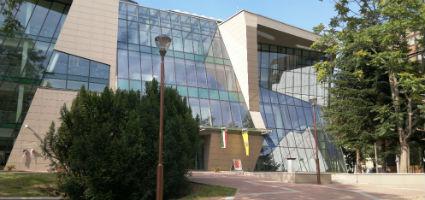2024. May 2. Thursday
Agora - Együd Árpád Cultural Center - Kaposvár
 |
Address: 7400, Kaposvár Csokonai u. 1.
Phone number: (82) 314-915
E-mail: vaszary@dravanet.hu
Opening hours: Tue-Sat 10-18
|
The exhibition has closed for visitors.
2015.03.20. - 2015.05.20.
Museum tickets, service costs:
|
Ticket for adults
|
1000 HUF
|
|
|
Ticket for students
|
500 HUF
|
|
|
Ticket for pensioners
|
500 HUF
|
|
|
Ticket for families
(2 adults + 2 children)
|
2000 HUF
|
/ family
|
The painter Gyula Zoltán Feledy (29 January 1975, Szombathely) turned to painting in the 1990s. By that time, he had had a successful veterinary career behind him and been the mayor of his town. His uncle, Gyula Feledy was a Kossuth Prize awarded graphic artist therefore Gyula Zoltán Feledy was naturally involved in art. His special artwork collection, and also his studying the art of Miro and Klee directed his interest in the direction of artistic self-expression.
His artist friends, György Szőke and János Megyik encouraged him to experiment with painting. His early works were spontaneous utterances of free associations. He worked attracted to abstract expressionism. His pictures revealed combinations of elements of painting and graphics. His works from the 90s were closely related to eastern calligraphy, in which the brushwork reflected on his automated spiritual aura.
His works are made with the help of a medium located between the artist and the work of art: these may be a camera or a computer. Motivated by his interest in sociology, originally he was involved in photo anthropology: He processed archive photographies from the 20th-century taken in Kötcse. He approached the central theme of his pictures, the relations of people from the point of view of social criticism. By the millennium, he published an independent media material titled "Life in Kötcse in Pictures," which was the first piece in the multimedia collection owned by the National Museum.
During the years of 2000s, due to changes in his life, he searched for new methods of photography, trying to withdraw from the everyday world. His new creations are photograms were made involving special technique, which are objective image analysis of the temporal movement of beam. He projects colourful light beams on each other in front of a dark background, then he photographs these. The new images put series of ever-changing light manifestations into new dimensions of space and time. The creation of Balázs Feledy's image stories are also aided with another medium: the computer. The interplay of multi-layered, transparency creates special light symphonies after editing them on the computer. These, mostly geometric works can be characterised in terms of composition with asymmetry, transitions between edges and cuts, and plane of truss structures, as well as effects of light and shadow. His electrographies are closed systems, the elements of which are pervaded by interdependence and dependence from the whole system. The closed structure consists of layers, which are constructed hierarchically which he studies, or he may study the linear-like structure. He uses 3D display and fractal graphics as well. His pictures make up are sequels, which, starting from the minimum, become more and more complex when adding more and more elements and build up complex visuals and dynamic associations.
His artist friends, György Szőke and János Megyik encouraged him to experiment with painting. His early works were spontaneous utterances of free associations. He worked attracted to abstract expressionism. His pictures revealed combinations of elements of painting and graphics. His works from the 90s were closely related to eastern calligraphy, in which the brushwork reflected on his automated spiritual aura.
His works are made with the help of a medium located between the artist and the work of art: these may be a camera or a computer. Motivated by his interest in sociology, originally he was involved in photo anthropology: He processed archive photographies from the 20th-century taken in Kötcse. He approached the central theme of his pictures, the relations of people from the point of view of social criticism. By the millennium, he published an independent media material titled "Life in Kötcse in Pictures," which was the first piece in the multimedia collection owned by the National Museum.
During the years of 2000s, due to changes in his life, he searched for new methods of photography, trying to withdraw from the everyday world. His new creations are photograms were made involving special technique, which are objective image analysis of the temporal movement of beam. He projects colourful light beams on each other in front of a dark background, then he photographs these. The new images put series of ever-changing light manifestations into new dimensions of space and time. The creation of Balázs Feledy's image stories are also aided with another medium: the computer. The interplay of multi-layered, transparency creates special light symphonies after editing them on the computer. These, mostly geometric works can be characterised in terms of composition with asymmetry, transitions between edges and cuts, and plane of truss structures, as well as effects of light and shadow. His electrographies are closed systems, the elements of which are pervaded by interdependence and dependence from the whole system. The closed structure consists of layers, which are constructed hierarchically which he studies, or he may study the linear-like structure. He uses 3D display and fractal graphics as well. His pictures make up are sequels, which, starting from the minimum, become more and more complex when adding more and more elements and build up complex visuals and dynamic associations.